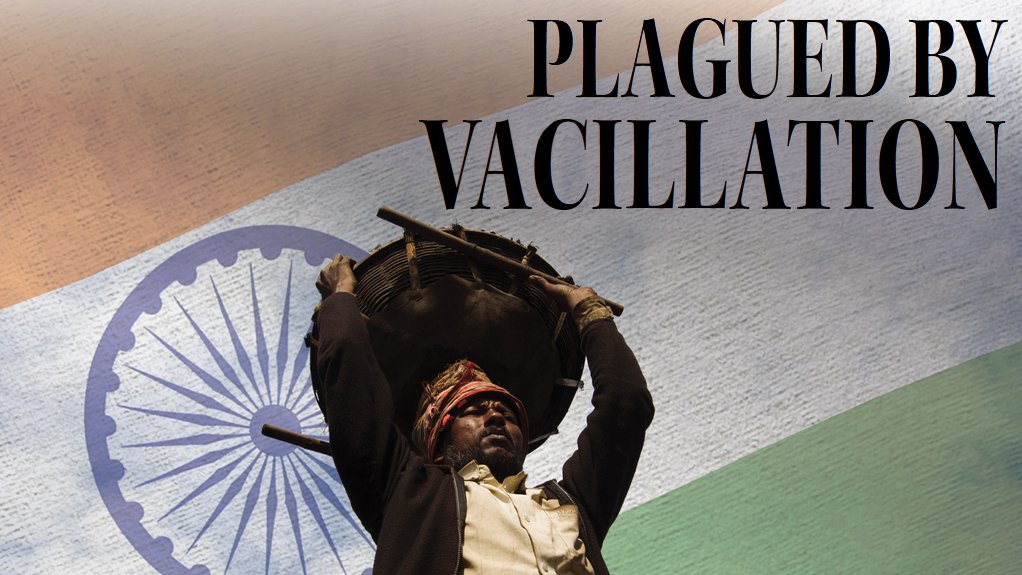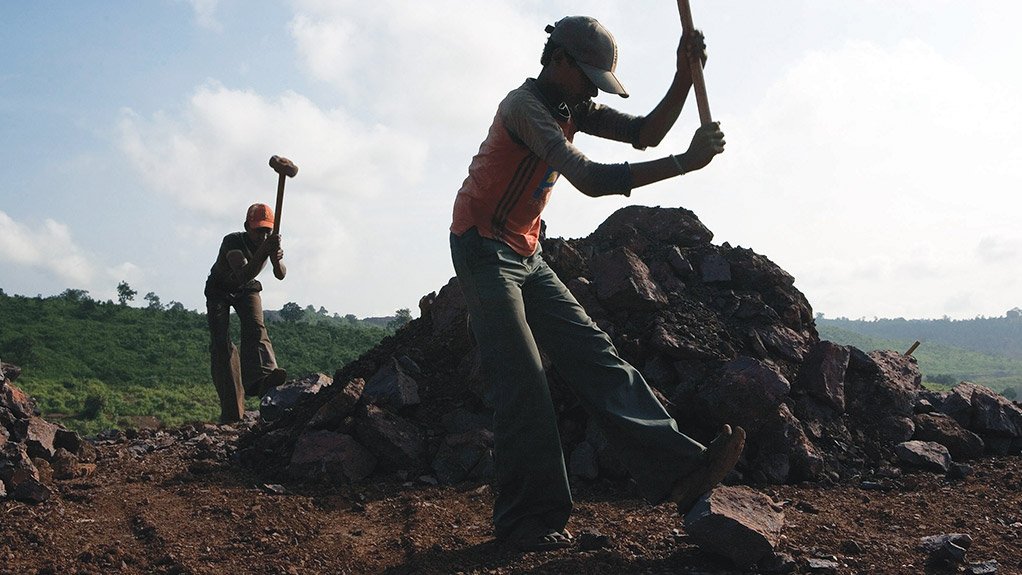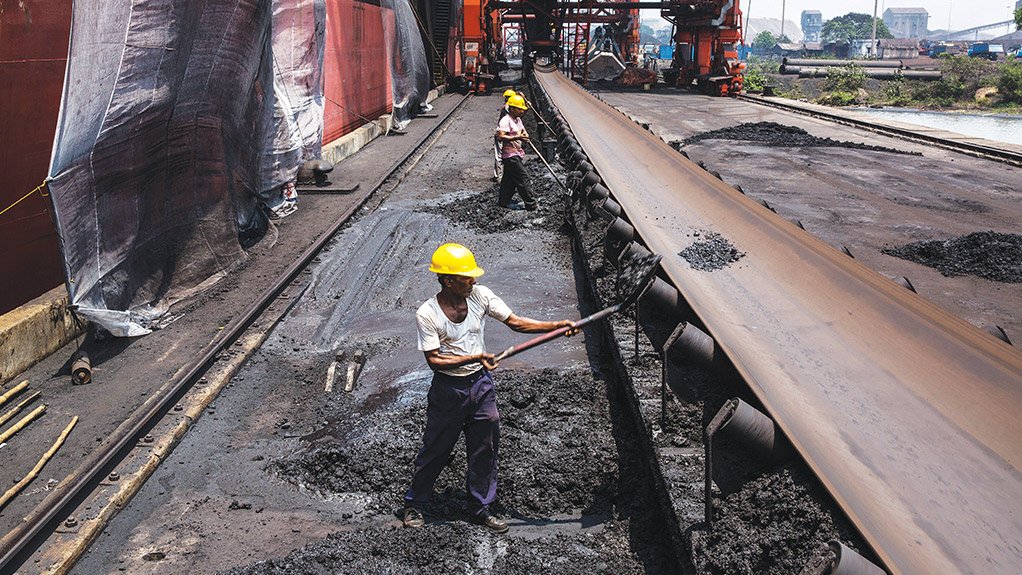Policy dilly-dallying hampering recovery of India’s crisis-stricken mining sector






HOPE FOR THE FUTURELed by newly electer Prime Minister Narendra Modi, the Bharatiya Janata Party (BJP), took charge of India in May, after the BJP’s landslide victory in the national elections
SWORN IN Narendra Modi, seated left, participates in a swearing in ceremony for India’s new Cabinet members at the Presidential Palace in New Delhi, India
PRODUCTION DOWN Indian iron-ore production dropped from 230-million tons a year in the 2009/10 financial year to 140-million tons a year in 2013/14
IMPORTS ON THE RISE Coal imports skyrocketed from 60-million tons in the 2009/10 financial year to 171-million tons in the 2013/14 financial year
India’s newly elected government has the difficult task of trying to bridge the divide between the country’s mining potential and its tendency to procrastinate in policy- and decision-making.
Delays, corruption, legislative inaction, illegal mining and a weak regulatory environment have become synonymous with the Indian mining sector, resulting in the chasm widening under pre- vious governments.
Previous administrations have had lofty expectations. India’s Ministry of Mines published the ‘Unlocking the potential of the Indian minerals sector’ strategy paper in 2011, which states that the mining sector could contribute about $250-billion, or between 6% and 7% of gross domestic product (GDP) and create 15-million direct and indirect jobs by 2025.
According to the report, action is required on six key priorities – enhancing the resource and reserve base through exploration and international acquisition; reducing permit delays; establishing core enablers of infrastructure; fast-tracking human capital and technology; ensuring sustainable mining development; and creating information, education and communication strategies.
Although these proclamations were passed in 2011, the sector has continued to decline.
GDP Contribution
In the 1992/3 financial year, India’s mining sector contributed 3.4% to the country’s GDP. This contribution declined to 3% in the 1999/2000 financial year and dropped to 2.3% in 2009/10.
Further, with the sector contracting in absolute terms in the past two years, the Indian mining sector’s contribution to the country’s GDP dropped to between 1.2% and 1.9% in the 2012/13 financial year.
Therefore, the new government still has a lot to do if it is to get the economy on track to meet the 6% to 7% of GDP growth target – India’s economic growth sputtered to below 5% during the fourth quarter of 2013, with the mining sector registering a negative growth of 1.9% for the fourth consecutive quarter.
Meanwhile, Indian iron-ore production dropped from 230-million tons a year in the 2009/10 financial year to 140-million tons a year in the 2013/14 financial year. By contrast, coal imports skyrocketed from 60-million tons in the 2009/10 financial year to 171-million tons in the 2013/14 financial year.
Legislative Environment
The primary legislative framework for India’s mining industry is the Mines and Minerals Development and Regulatory (MMDR) Act of 1957. Although the aim of the MMDR Act Amendment Bill of 2011 was to update the legislative environment, India’s administration change in May 2014 resulted in the Bill never being passed.
Similarly, India has, since 2012, adopted a wait-and-see approach to its coal block auction policy of allocating resources on market- based principles. A list of coal blocks drafted for auction by India’s Ministry of Coal was based on an assessment dating back to 1999. Owing to socioeconomic and environmental reasons, companies in the steel and cement sectors did not participate, with townships having been established in the interim on one of the blocks.
“Flip-flop policies created room for interpretation for the Indian mining sector, which [is facing] several challenges. We are sure that the mining industry can be fixed, but there are no shortcuts,” India Power Corporation chair person Hemant Kanoria tells Mining Weekly.
Kanoria, who has interests in thermal power generation and coal mining, heads Srei Infra- structure Finance, a key role-player in project and equipment financing for the construction and mining sectors.
“There is a lack of clarity on land acquisition, relocation and rehabili- tation policy [and] a tremendous lack of alignment between the federal and provincial governments,” he adds.
Kanoria says the new government needs to concentrate on two issues regarding its short-term agenda. Firstly, it needs to create a single window for resolving all issues pertaining to forest and environment clearances. Secondly, government should tackle land acquisition issues for certain major projects under way in the country and would, therefore, also be playing an important role in resolving them.
The current 63 395 mineral concession applications pending at various provincial governments bear out Kanoria’s concern. According to a Mines Ministry circular released in May 2014, the southern Indian province of Karnataka topped the list, with 19 497 applications pending. Rajasthan has 13 893 applications pending, Andhra Pradesh 7691, Madhya Pradesh 4 680, Gujarat 4 517 and Jharkhand 4 409.
According to mining industry officials, it takes at least five years to secure all clearances and approvals from federal and pro- vincial governments.
“In most provinces, renewal of mining leases – captive and noncaptive – are not [awarded] within the prescribed timeframe and leases operate under a deemed extension clause in the mineral concession rules . . . of 1960,” Federa- tion of Indian Mineral Industries chairperson Hukam Chand Daga tells Mining Weekly.
“This has created total uncertainty in the mining sector, which is the root cause of industry overshooting the production limits mentioned in environmental clearances – this is dubbed illegal mining,” he adds.
Regarding medium-term measures expected from government, Kanoria adds: “Government needs to rationalise the MMDR Act and the Land Acquisition Rehabi- litation and Resettlement Act, creating vehicles for people and industry. It also needs to update land records immediately, which has not been done for several decades.”
Meanwhile, the new government, unlike previous ones, will need to refocus its minimal government spending. An entire chain of mining operations cannot yield optimal leveraging of potential, with government’s funding crunch, or with 70% of mining production, in terms of value, being accounted for by government-owned mining companies, while the private sector is left with captive mining with highly fragmented holdings.
It is little wonder that, despite its significant potential, India’s mining sector does not have any standalone resource majors, like London-headquartered Rio Tinto, Australia’s BHP Billiton, or Brazil’s Vale.
“Evolving multidimensional resource majors in the country would require the sector to be 100% open to foreign direct investments (FDI), with a matching transparent resource allocation process and clarity of regulation to avoid government intervention in operations,” Alloy Steel Producers Association chairperson Suketu Shah tells Mining Weekly.
“Inviting international mining experts to operate mines in partnerships, finalise royalty rates in line with international prac- tices and improve infrastructure for ease of movement up to consumption points need to be addressed by the new government,” he notes.
Kanoria adds that FDI has not flowed into the mining sector, as government does not have a stance on the allocation of natural resources.
“You cannot have a policy which leads to suboptimisation of resources because of fragmentation and . . . ask industries to be cost competitive. Being a resource- hungry nation, we need to direct FDI judiciously into exploration, technology upgrades and mining operations,” he says.
Several industry representative bodies have petitioned government for an ‘open sky’ policy to attract investments covering reconnaissance permits, ensure seamless transitioning from prospecting licences to mining leases, and guarantee the rights to sell and transfer the licences and leases.
Current Administration
The incumbent Indian government, led by Prime Minister Narendra Modi, of the Bharatiya Janata Party (BJP), took charge in May, after the BJP’s landslide victory in the national elections. The BJP’s election campaign was based on the promise of efficient governance and reversing the policy paralysis of the previous government.
On June 27, after one month in office, the Prime Minister – in a review of the mining sector – was advised by the Mines Ministry that, pending mining legislation, particularly the MMDR Act, expediting environmental clearances and fresh fund infusion were key to reviving the sector.
So, is optimism breaking through the gloom of India’s habitual procrastination?
The jury is still out on the current government’s ability to remedy the crisis-stricken mining sector, but the pace at which the mining sector operated in the past could be an indicator for the future. Mining sector legislation has been on the anvil since 2011 and, although a National Mineral Policy was established in 1993, it was last updated in 2008. Further, the coal sector regulatory legislation was first drafted in 2008 and, despite the previous government approving the revised Bill of 2013, it has since lapsed. Subsequently, government will have to reintro- duce it to Parliament.
Clearly, a decade is a short time in the Indian mining sector, as – to paraphrase Shakespeare – time evidently has not been the justice that examines the offenders.
Comments
Press Office
Announcements
What's On
Subscribe to improve your user experience...
Option 1 (equivalent of R125 a month):
Receive a weekly copy of Creamer Media's Engineering News & Mining Weekly magazine
(print copy for those in South Africa and e-magazine for those outside of South Africa)
Receive daily email newsletters
Access to full search results
Access archive of magazine back copies
Access to Projects in Progress
Access to ONE Research Report of your choice in PDF format
Option 2 (equivalent of R375 a month):
All benefits from Option 1
PLUS
Access to Creamer Media's Research Channel Africa for ALL Research Reports, in PDF format, on various industrial and mining sectors
including Electricity; Water; Energy Transition; Hydrogen; Roads, Rail and Ports; Coal; Gold; Platinum; Battery Metals; etc.
Already a subscriber?
Forgotten your password?
Receive weekly copy of Creamer Media's Engineering News & Mining Weekly magazine (print copy for those in South Africa and e-magazine for those outside of South Africa)
➕
Recieve daily email newsletters
➕
Access to full search results
➕
Access archive of magazine back copies
➕
Access to Projects in Progress
➕
Access to ONE Research Report of your choice in PDF format
RESEARCH CHANNEL AFRICA
R4500 (equivalent of R375 a month)
SUBSCRIBEAll benefits from Option 1
➕
Access to Creamer Media's Research Channel Africa for ALL Research Reports on various industrial and mining sectors, in PDF format, including on:
Electricity
➕
Water
➕
Energy Transition
➕
Hydrogen
➕
Roads, Rail and Ports
➕
Coal
➕
Gold
➕
Platinum
➕
Battery Metals
➕
etc.
Receive all benefits from Option 1 or Option 2 delivered to numerous people at your company
➕
Multiple User names and Passwords for simultaneous log-ins
➕
Intranet integration access to all in your organisation























